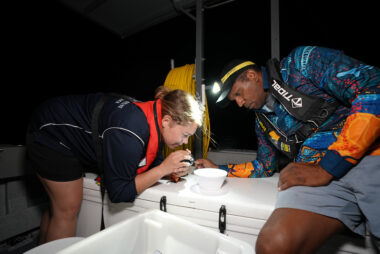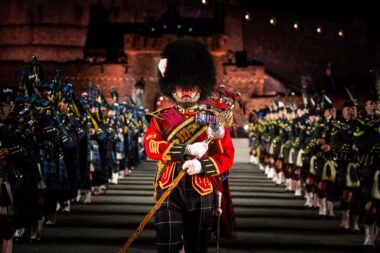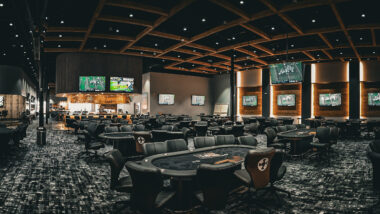More Science Week stories around New South Wales
- Your brain on AI at the Sydney Opera House
- Dr Karl, the Surfing Scientist, slugs and snails, plant invasions, and a T.rex autopsy at the Sydney Science Trail
- Telescopes and TikTok: meet Indigenous astrophysicist and social media star Kirsten Banks – Ryde & Albury
- Sleeping with cancer – Westmead
- Follow food from lips to lavatory: step inside the Poo Palace – Newcastle
- Passport to Space: overcoming barriers to diversity, equity and inclusion in the space sector – Parramatta
- The Indigenous night sky, bush food, and technology – Redfern
- Creative genius and your ‘visual brain’ – Sydney
- Can you see the stars? Dark skies versus light pollution
More on these highlights below.
Scientists, experts and event organisers are available for interview throughout National Science Week.
Read on for direct contact details for each event, or contact Tanya Ha – [email protected] or 0404 083 863.
Visit ScienceWeek.net.au/events to find more stories in your area.
Media centre here. Images for media here.
Looking for life in space: NSW launch today at 8:30am at WSU Observatory
National Science Week in NSW will be officially launched at the Campbelltown Rotary Observatory, the home of the Australian Optical SETI (OZ OSETI) Project, searching the Universe for signs of extraterrestrial intelligence. It is the only dedicated optical SETI project in the Southern Hemisphere.
With:
- Professor Hugh Durrant-Whyte, NSW Chief Scientist & Engineer and Natural Resources Commissioner
- astronomy demonstrations.
Where: WSU UniClinic Brian Smith Dr, Campbelltown NSW 2560
Media enquiries: Meredith Hall, Inspiring NSW, [email protected], 0421 614 145.
Your brain on AI at the Opera House – Sydney
Paul Davies, the inventor of DishBrain, and others will discuss how our brains are going to change with AI.
Paul asks if we relinquish our intellectual supremacy in favour of thinking machines.
What makes a mass of cells come together to think, do and become self-aware?
Technologies like DishBrain, brain organoids and organic AI – using the computing power of brain cells – could revolutionise fields from neuroscience and psychology to data science and robotics.
But how do intelligence and consciousness arise? How are emotions and feelings generated? How do our brains adapt to technological evolution?
The University of Sydney AI expert Sandra Peter will explore these topics in a panel event at the Sydney Opera House, featuring:
- renowned British quantum physicist, cosmologist, author and TV presenter Paul Davies
- neuroscientist, DishBrain co-inventor, and Chief Scientific Officer at Cortical Labs Brett Kagan
- cognitive scientist and expert on brain-computer interfaces Inês Hipólito.
Saturday 17 August. Event details: www.scienceweek.net.au/event/sydney-opera-house-your-brain-on-ai/sydney
Paul Davies, Ines Hipolito, Brett Kagan, and Sandra Peter are available for media interviews.
Media enquiries: Emily Cook, [email protected], 0484 566 133.
Dr Karl, the Surfing Scientist, slugs and snails, plant invasions, and a T.rex autopsy at the Sydney Science Trail – Sydney
Hear the weirdest science questions answered by Dr Karl, try plant science experiments with the Garden’s botanists, and learn about First Nations science knowledge. Chat to scientists and discover the latest innovations in their research at our Science Expo. Watch a T.rex Autopsy show, learn about megafauna, and meet Winny the Muttaburrasaurus, our roving puppet dinosaur.
This day of science is presented by the Australian Museum in collaboration with Botanic Gardens of Sydney. This family-friendly event is hosted by the Surfing Scientist, Ruben Meerman.
Saturday 17 August. Event details: www.scienceweek.net.au/event/sydney-science-trail-community-day-2/sydney
Talent available for media interviews from Australian Museum; media contact: Claire Vince, [email protected] or 0468 726 910.
- Curator of Fishes Dr Yi-Kai Tea (Kai the fish guy)
- Malacology (slugs and snails) researcher Dr Isabel Hyman.
From Botanic Gardens of Sydney; [email protected] or 02 9231 8122.
- Dr Hannah McPherson from can discuss the latest active research on Australia floral diversity
- Living Collection Curator Mike Elgey can discuss how the garden plantings and nursery contribute to conservation
- Dr Patricia Lu-Irving can discuss her work understanding plant invasions.
For Ruben Meerman, contact Tanya Ha, [email protected] or 0404 083 863.
Telescopes and TikTok: meet Indigenous astrophysicist and social media star Kirsten Banks – Ryde & Albury, NSW
Gaze at stars, learn about Indigenous astronomy, and find out the secrets of black holes with Dr Kirsten Banks, a passionate astrophysicist and science communicator with a lifelong fascination for the cosmos.
Kirsten has pursued a life-long love for space, earning a PhD in astrophysics, and delving into the depths of the Milky Way galaxy. As a proud Wiradjuri woman, Kirsten explores the mysteries of the universe and honours the rich knowledge of her ancestors.
You’ll often find Kirsten sharing her love for astronomy and space with more than 500,000 followers across social platforms such as TikTok, Instagram and YouTube.
Ryde: Tuesday 13 August. Event details: www.scienceweek.net.au/event/first-nations-astronomy-and-stargazing-with-dr-kirsten-banks/ryde/
Albury: Friday 16 August. Event details: www.scienceweek.net.au/event/first-nations-astronomy-and-stargazing/albury/
Media enquiries: [email protected]
Sleeping with cancer - Westmead
Cancer patients have enough to deal with without sleep apnoea. Learn about the biology of how cancer impacts rest and how patients can improve their sleep quality with Associate Professor Kristina Kairaitis.
Kristina leads the Sleep & Cancer Group at the Westmead Institute for Medical Research, the first group in Australia to investigate why disturbed sleep may be relevant in cancer.
Thursday 15 August. Event details: www.scienceweek.net.au/event/westmead-institute-for-medical-research-science-week-2024/westmead
Media enquiries: Kylie Ironside, [email protected] or 0413 611 959.
Step inside the Poo Palace – Newcastle
Experience the journey that food goes on, and ask the experts about digestion, farts and faeces, gut health and good bacteria.
The Poo Palace is a giant inflatable re-creation of the digestive system where children take a sensory adventure through the gastrointestinal tract, from lips to lavatory.
The Poo Palace is made up of 4 modules that mimic the journey food takes along the digestive tract (mouth, stomach, small intestine, large intestine).
Children learn first-hand how food moves through the body, and through live experiments with researchers from the Hunter Medical Research Institute.
Saturday 17 - Sunday 18 August. Event details: www.scienceweek.net.au/event/the-poo-palace/newcastle
Media enquiries: Tracy McKelligott, [email protected] or 0415 499 409.
Passport to Space: overcoming barriers to diversity, equity and inclusion in the space sector – Parramatta
Participation of diverse and minoritised groups is one of the biggest challenges facing the space sector globally. On the question of gender parity alone, just one in five workers are women.
Indian space entrepreneur and habitat designer, Dr Susmita Mohanty, and Lebanese remote sensing scientist, Dr Maya Nasr, join forces to disucss their shared vision for space exploration that is accessible to all.
‘Passport to Space – Susmita Mohanty and Maya Nasr’ is a National Science Week event at Paramatta Town Hall which forms part of the Sydney Science Festival, presented by Powerhouse.
Thursday 15 August: https://www.scienceweek.net.au/event/passport-to-space-susmita-mohanty-and-maya-nasr/parramatta/
Media enquiries: Michelle Lollo, [email protected] or 0419 523 735.
The Indigenous night sky, bush food, and technology – Redfern
What can Aboriginal astronomy tell us about the night sky? How are native flora used in bush medicine and soap making? How do Indigenous Australians make axes from stone and other artefacts? What can deadly science tell us about seaweed, birdlife, engineering, textiles, and more? What can 60 000+ years of Indigenous culture tell us about sustainable living?
The Indigenous Science Experience at Redfern is a celebration of Indigenous and Western science, and the achievements of Indigenous youth and Elders. This annual event demonstrates the value of traditional and contemporary Indigenous knowledge in science and technology. Indigenous students assist in demonstrating activities.
Saturday 17 August. www.scienceweek.net.au/event/indigenous-science-experience-at-redfern-4/redfern/ Media enquiries: Joanne Jamie, [email protected], 0439 170 683 or 02 9850 8283.
Indigenous student leaders, First Nations activity providers, and event organiser Joanne Jamie (non-Indigenous) are available for media interviews. View video from 2023 event.
Creative genius and your ‘visual brain’ – Sydney
What happens in your brain when you encounter multi-sensory experiences, like art?
David Alais, a Professor of Experimental Psychology at University of Sydney, is fascinated by the way art can reveal the ‘visual brain’ at work.
In ‘Study in Visual Perception’, he examines how the work of Austrian born artist, Lily Greenham, reveals the brain’s visual processes in action and its limitations.
Bottom line: science is catching up with recent advances in neuroscience, shining new light on the mysteries of vision, creativity and aesthetics.
Thursday 15 August: www.scienceweek.net.au/event/study-in-visual-perception-a-public-lecture-by-professor-david-alais-4/the-university-of-sydney
Media enquiries: [email protected] or 02 8627 0246 (diverts to mobile)
Why can’t you see the stars? – online
What happened to the night sky? The Milky Way is no longer visible to an estimated third of humanity, including more than half of Australians, thanks to light pollution.
This August, the ABC is exploring the dark sky and the impact of light pollution on science, creatures, and culture. Light pollution in the night sky is a problem for astronomers and stargazers, it confuses the circadian rhythms of some creatures and misguides the navigation of others, impacts Sky Country and Indigenous cultural practices, and contributes to sleep deprivation in humans.
ABC Science will invite people to explore the dark sky, contribute to an Australian National University study of the Milky Way’s visibility, see solutions to light pollution, stargaze with Radio National and guest astronomers, and vote in their poll on ‘the most amazing thing you’ve seen in the night sky.’
Monday 31 July – Friday 16 August: www.scienceweek.net.au/exploring-dark-skies-with-abc/ or www.abc.net.au/nightsky.
Media enquiries: Shelley Thomas, [email protected] or 0416 377 444
Scientists available for media interviews.



